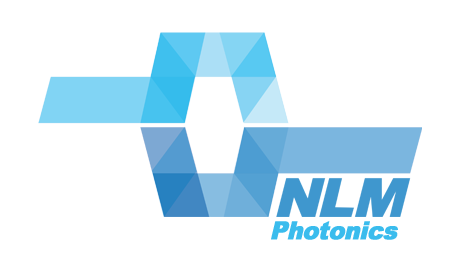Cheers to 2024 as We Revisit NLM’s 2023 Successes
Incredible partnerships, innovations, and scientific advancements
At NLM Photonics, our 2023 was shaped and transformed by the insatiable hunger for greater computing and networking power in the age of artificial intelligence (AI) and machine learning. Our hybrid organic electro-optic technology continues to show enticing advantages in power efficiency and bandwidth for datacom applications. In our R&D, robust testing focusing on long-term stability and repeatable and scalable processing, along with further development of new materials and IP portfolio expansion, set us on a grounded path forward.
Invaluable resources: industry events and partner collaborations
We continue evangelizing and spreading industry awareness around devices using organic electro-optic materials at industry-leading conferences, events, and meetings. We kicked off 2023 by hosting our first exhibition booth at Photonics West. We ended the year with an invited talk at the European Conference on Communications (ECOC) by our Chief Scientific Officer, Dr. Lewis E. Johnson. We also attended OFC, Optica’s Executive Forum, TechConnect World Innovation, Leti Innovation Days, DARPA’s ERI Summit, IEEE’s Research and Applications of Photonics in Defense, and Optica’s Photonic-Enabled Cloud Computing Industry Summit. Lewis and Dr. Delwin L. Elder also co-presented a poster at TechConnect World Innovation.
We continue our robust collaborations with global partners as we expand product designs, prototypes, testing, and material improvements, including supply and licensing agreements. We’re honored to work alongside some of the greatest minds and most dedicated scientists in this industry, including Tokyo Ohka Kogyo Co., Ltd. (“TOK”), Hamamatsu Photonics, Polariton Technologies, CEA-Leti, AIM Photonics, and the University of Washington, among others. At ECOC, Optica’s Jose Pozo caught up with our CEO Gerard Zytnicki and Polariton co-founder Dr. Benedikt Baeuerle about NLM’s technology and our companies’ partnership.
Funding and strategic partnership expansion
Operationally, we secured over $1 million in new strategic investment from our CVC partners, bringing aboard TOK and further cementing our relationship with Hamamatsu Photonics. As part of the deal with TOK, we started a project to develop shelf-stable chromophore inks to improve the ease of use of our materials by fabs.
We also landed a NASA Phase I Small Business Technology Transfer (STTR) grant for further funding, introducing our technology to various government agencies and creating devices strong and stable enough to withstand the harsh environment of space. We completed a tape-out (submission of a validated photonic integrated circuit design for fabrication) with AIM Photonics with various designs for silicon-organic hybrid modulators. This tape-out enables testing key capabilities and processes and providing test chips to private sector and government customers. NASA has been very enthusiastic about our technology due to the tight power and weight constraints on spacecraft.
The US Air Force awarded us a Phase I AFWERX Small Business Innovative Research (SBIR) contract for developing engagements with defense customers related to our technology. We have submitted our proposal for a Phase II award to further our development efforts for defense and commercial applications.
Teamwork, new labs, and cutting-edge R&D
We celebrated five years as a startup in August and had our first all-team offsite since 2021 last May. We reflected on the past and envisioned our future for the team, company, product, and culture, including where we want to be in the next 3-5 years.
We expanded our board with industry veteran and technology leader Brad Booth; he has already provided invaluable guidance, connections, and more to our team. He brings extensive knowledge and experience in AI and cloud computing from his work at Microsoft, Intel, and Meta. Brad is a founder of ethernet coalitions that developed the standards used globally and holds over 20 patents in networking technology. He has opened the door for a deeper understanding of our future direction and more industry connections.
Over several months, we moved our facilities from the academic space we utilized at the University of Washington to our own facilities at the CoMotion Labs startup incubator. These new facilities allow us to expand our commercial work and anticipate future team growth, while retaining a convenient location on the University of Washington campus directly above the Washington Nanofabrication Facility. Our facilities include a wet lab and a dedicated photonics test lab with more advanced capabilities than we previously had access to, including a highly customized Maple Leaf Photonics optical probe station for poling and EO tests.
We also continued to demonstrate production scalability and repeatability for our commercial materials, with an over 5x increase in scale relative to prior materials batches, keeping us well positioned for customer and R&D demand.
Growing our IP block and scientific literature and proof-point expansion
To support this, along with our partner CoMotion at UW, we secured a new US patent for our record-setting organic electro-optic material, BAH13. BAH13 features high electro-optic activity greater than 1,000 pm/V.
APL Materials published a review paper led by UW Professor Emeritus Larry Dalton, “Nanophotonic electro-optics enabling THz bandwidths, exceptional modulation and energy efficiencies, and compact device footprints,” in their May issue. This paper is coauthored by Delwin, Lewis, and Dr. Scott Hammond, our partners at Polariton, and our long-time advisor, Dr. Bruce H. Robinson.
At ECOC, two of our partners presented key stability results for qualifying our technology for data center use. Adrian Schwarzenberger at KIT presented in-device high-temperature storage stability data at 85 °C and 120 °C with modulators using our chromophores. They showed no change after 6000+ hours at 85 °C and maintenance of capability for 100 Gbaud PAM4 data transmission after over 2,000 hours at 120 °C. This is the first demonstration we are aware of with an organic material maintaining high electro-optic modulation performance after long-term exposure to that high of a temperature. The presentation followed up on preliminary results presented by Prof. Christian Koos (KIT/SilOriX) at OFC. Dr. Claudia Hoessbacher at Polariton Technologies also presented work showing long-term laser power survivability for plasmonic devices utilizing our materials.
We are looking forward to 2024!
As 2024 kicks off, we go forward with incredible prospects that 2023 and our fifth year in operation set us up for. We cannot wait to continue to grow our fantastic team, collaborate with partners, and push the capabilities of integrated photonics. Data centers continue to grow, and hyperscalers need innovation to bend the bandwidth/power curve down and deliver the incredible possibilities of AI and beyond. At no time has photonics been better positioned for rapid growth than now, and we believe in NLM’s potential to be at the forefront of that revolution.



